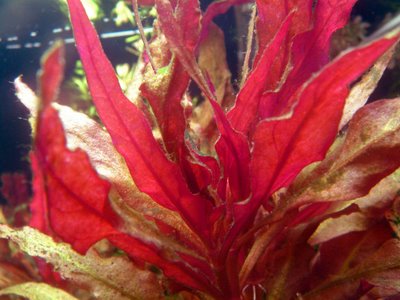- pH:
- Temp:
- KH:
- GH:
- NH4:
- NO2:
- NO3: 5-10
- PO4: 0.75
- Iron:
- Dosing: 30 mL KNO3 (7.5 ppm), 20 mL KH2PO4 (0.8 ppm)
- NO3:PO4 Cumulative Dosing Ratio: 15:1.55 = 9.7
Notes:Yesterday, I finally received the Vortex XL diatom filter, and tried it out. The instructions on the manual weren't great, as other people have noted. I recommend that you do a search to find better instructions given by people who have actually set it up.
Here's what I do to run the filter:
-Fill the jar halfway with water and seal the jar.
-Put the intake and outtake tubes into the tank. Turn on the filter, and turn the jar upside down until you see the intake tube fill with water. Turn the filter off. This will create suction so that the filter jar will fill up with water. Once it has done so, turn the power back on. The filter should now be running with water.
-Take a small bucket or large cup that is big enough to hold both the intake and outtake tubes in the bucket/cup under water. Dip the bucket into your aquarium, and scoop out the intake and outtake tubes so that they are still under water in the bucket. Lift the bucket with the tubes out of the water.
-Add 3 cups of diatomaceous earth powder into the bucket of water. The filter should suck up the powder within a few minutes, and the powder should evenly coat the filter bag.
-An optional step if you feel the powder has not evenly coated the filter bag: Turn off the power (with the tubes still in the bucket). Wait a minute for the powder to fall off the filter bag. Turn the power back on, and wait a minute or two for the powder to recoat the bag.
-After the water is running clear in the bucket and the powder has coated the filter bag, lower the bucket with the tubes back into the aquarium. Remove the bucket. Your filter is now running! As recommended in the manual, the filter should be sitting lower than the aquarium (eg on the floor).
So far so good. But, although everything seemed to be working properly, the filter was not removing the algae, even after several hours! I checked all the connections. I tried different doses of powder, recharged the powder several times, but nothing changed. I was stumped, since I had read how people had no problems using the diatom filter to filter out their green water. I let it run overnight. In the morning, it had cleared the green water only very slightly.
Finally, today, I got some flocculant or water clarifier (Seachem Clarity), though I had been reluctant to use it initially. Supposedly, it can interfere with the fish gill function. I added the maximum dosage into the tank while running the diatom filter. Within minutes, the filters started to filter out the algae (as evidenced by the green film on the filter bag)! After a couple hours, the water flow reduced as the filter clogged up with the algae/flocculant. I recharged the filter, added another dose of the flocculant, and several hours later, the tank was crystal clear! Hallelujah! It was so clear, that I realized I had forgotten what my fish and plants looked like.
I was finally able to take a look at the new plants I had planted last Friday for the first time. The Rotala magenta is in very bad shape, it's more dead than alive, but I decided to keep it in there to see if it would revive. The Lobelia cardinalis looked fine, and the Echinodorus Kleiner Bar looked okay.
I then did about a 65-70% water change:
30 mL Amquel+
3 tsp baking soda
4 tsp Equilibrium
~40 mL Proquatics bacteria starter
Well, we'll see how clear the tank remains. Before/after pictures coming soon...

















